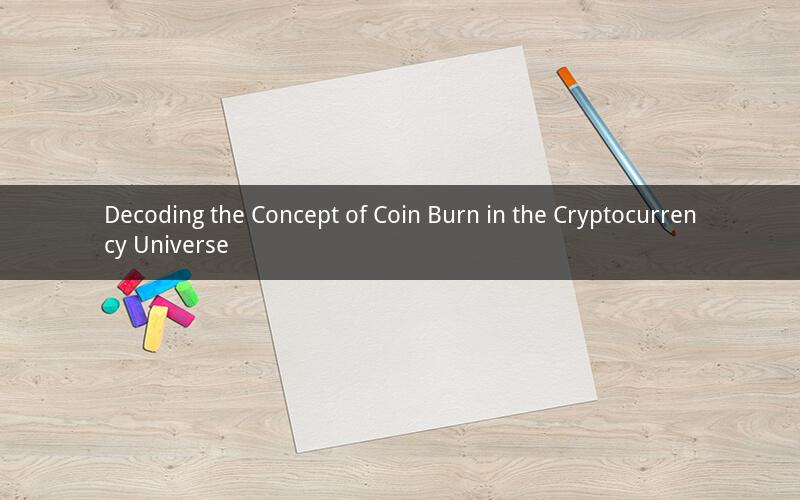
In the vast and rapidly evolving landscape of cryptocurrencies, one term that has gained significant attention is "coin burn." This practice, which involves the permanent removal of a specific number of coins from circulation, has sparked debates among enthusiasts, investors, and critics alike. In this article, we will delve into what coin burn is, its implications, and its role in the cryptocurrency ecosystem.
What is Coin Burn?
Coin burn is a process where a predetermined number of coins are destroyed or burned, rendering them non-circulating. This action is typically implemented by the creators or developers of a cryptocurrency to reduce the total supply of coins in circulation, thereby potentially increasing the value of the remaining coins. Unlike traditional fiat currencies, which can be printed or destroyed by governments, cryptocurrencies are built on decentralized networks and operate based on predetermined algorithms.
The Process of Coin Burn
The process of coin burn varies depending on the cryptocurrency and its underlying protocol. Generally, it involves the following steps:
1. Identification of coins to be burned: The cryptocurrency project identifies a specific number of coins to be removed from circulation.
2. Verification of coins: The network verifies the coins to be burned, ensuring they are not double-counted or manipulated.
3. Burning the coins: The coins are then removed from the network's ledger, rendering them non-circulating.
4. Notification of the burn: The cryptocurrency project typically announces the coin burn event to the public, providing transparency and accountability.
Reasons for Coin Burn
There are several reasons why a cryptocurrency project might choose to implement a coin burn:
1. Reducing supply: As mentioned earlier, one of the primary reasons for coin burn is to reduce the total supply of coins in circulation. This can potentially increase the value of the remaining coins, as demand for the cryptocurrency may outstrip the reduced supply.
2. Preventing inflation: Coin burn can help prevent inflation in a cryptocurrency. As the supply of coins decreases, the rate of inflation decreases, potentially leading to a more stable and sustainable value for the cryptocurrency.
3. Rewarding investors: By reducing the total supply of coins, coin burn can incentivize early investors and holders to hold onto their coins, as the value of their investment may increase.
4. Enhancing scarcity: Coin burn can make a cryptocurrency more scarce, which can be a positive factor in its value and marketability.
5. Demonstrating commitment: Coin burn can demonstrate a cryptocurrency project's commitment to long-term sustainability and reducing inflation.
The Implications of Coin Burn
While coin burn can have several positive implications, it also comes with certain risks and challenges:
1. Market manipulation: Some argue that coin burn can be used as a tool for market manipulation, where cryptocurrency projects artificially inflate the value of their coins by reducing supply.
2. Volatility: Coin burn can lead to increased volatility in the price of a cryptocurrency, as the reduced supply may cause rapid price swings.
3. Centralization: In some cases, coin burn can lead to centralization, as the process of burning coins is often controlled by a small group of developers or investors.
4. Legal and regulatory concerns: Depending on the jurisdiction, coin burn may raise legal and regulatory concerns, as it involves the destruction of digital assets.
5. Environmental impact: Coin burn can have an environmental impact, as the process of verifying and burning coins requires computational power, which often comes from energy-intensive mining operations.
Frequently Asked Questions (FAQs) about Coin Burn:
1. Q: Can coin burn be reversed?
A: No, coin burn is irreversible. Once coins are burned, they are permanently removed from the network's ledger.
2. Q: How does coin burn affect the price of a cryptocurrency?
A: Coin burn can potentially increase the value of a cryptocurrency, as it reduces the total supply of coins in circulation.
3. Q: Can any cryptocurrency implement a coin burn?
A: Yes, any cryptocurrency project can implement a coin burn, but it often requires network consensus and the cooperation of developers and miners.
4. Q: Is coin burn the same as a hard fork?
A: No, coin burn and hard forks are different concepts. While both involve changes to a cryptocurrency's network, coin burn focuses on reducing the supply of coins, while a hard fork involves creating a new blockchain with different rules.
5. Q: Can coin burn help a struggling cryptocurrency?
A: While coin burn can potentially improve the value of a struggling cryptocurrency, it is not a guaranteed solution. Other factors, such as market sentiment and the overall viability of the project, also play a significant role in determining a cryptocurrency's success.
In conclusion, coin burn is a complex and multifaceted practice that has both positive and negative implications. As cryptocurrencies continue to evolve, it is essential to understand the various aspects of coin burn and its role in the cryptocurrency ecosystem.